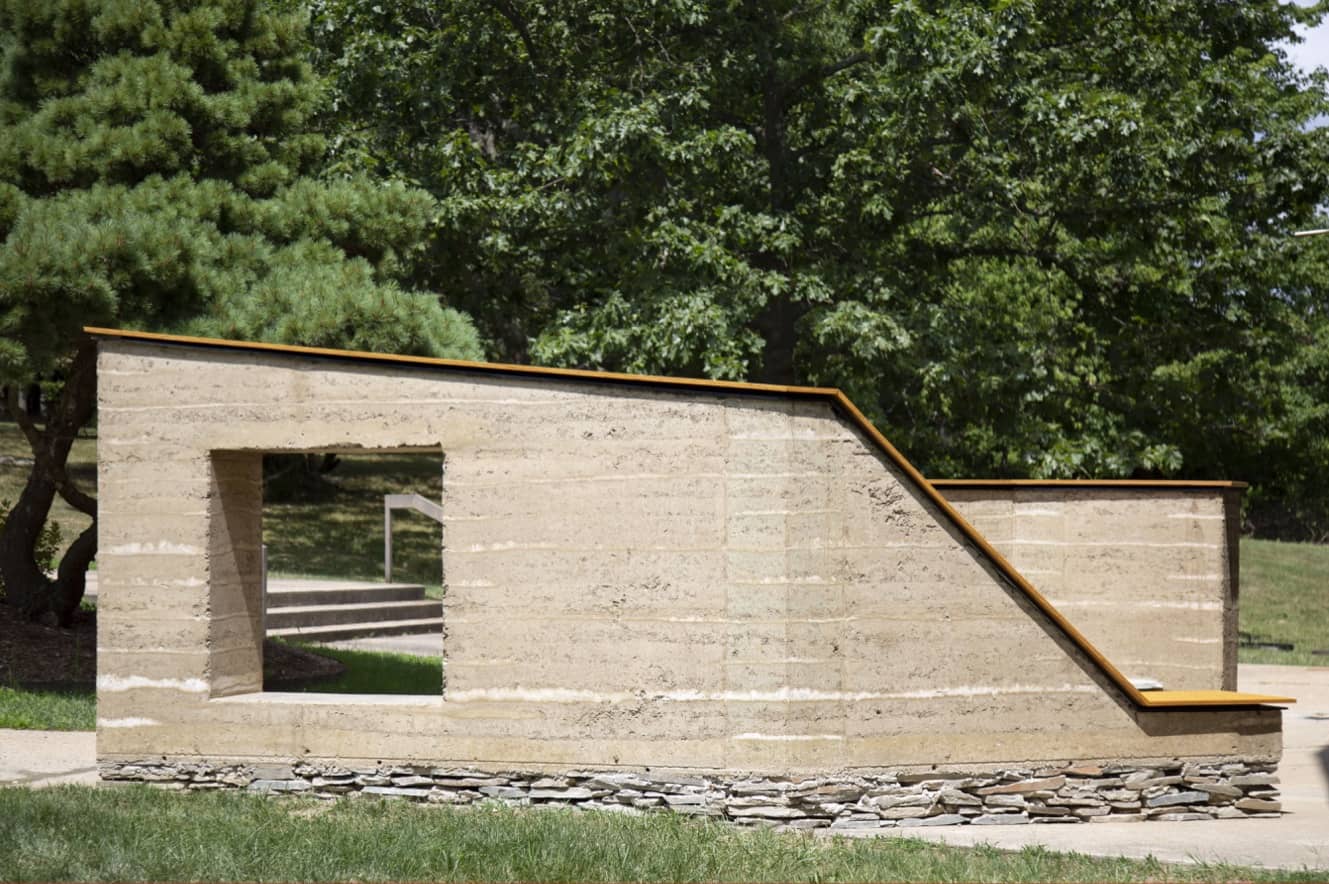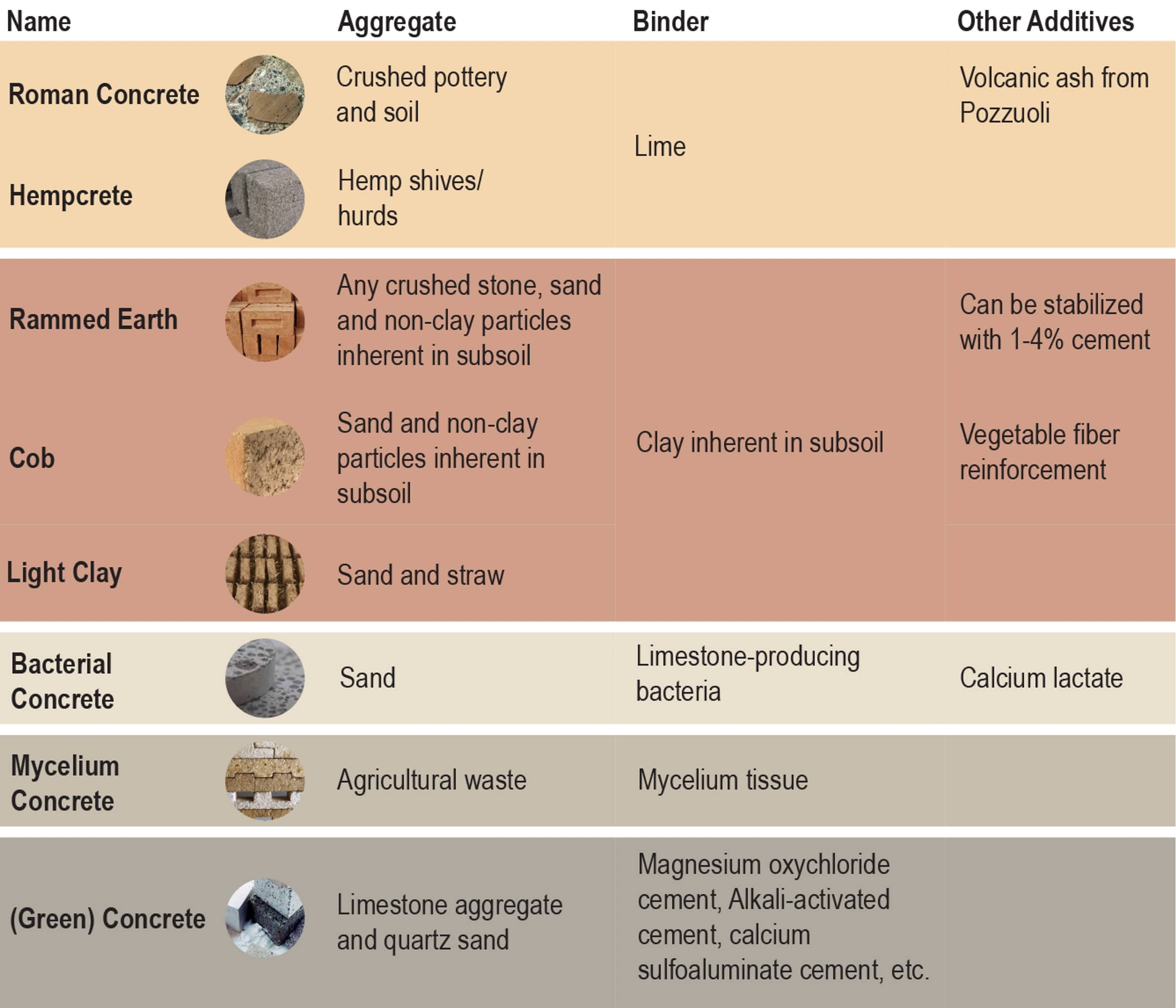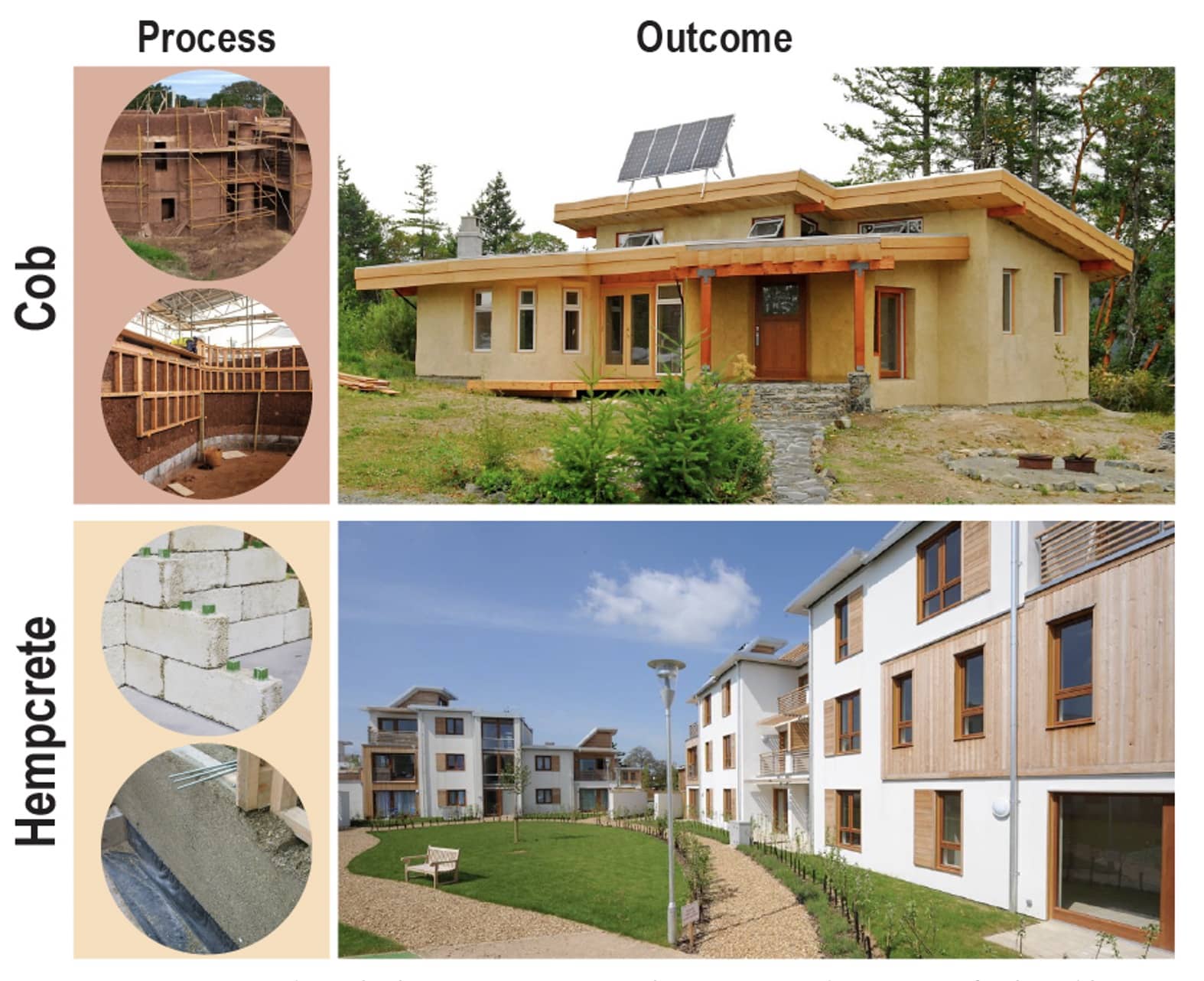
www.buildingsandcities.org/insights/commentaries/world-without-concrete.html
A World without Concrete?

Concrete has high environmental impacts. Can the construction industry reduce the volume of concrete that is used?
Can a world without concrete exist? Lola Ben-Alon (Columbia University) offers a lexicon of a myriad of concrete possibilities and questions where these materials stand in the hierarchy of decarbonising the built environment.
Concrete, or in its original Latin name concretus, is a 'compact' or 'solidified' matter made of aggregate and binder. As such, concrete can be defined as an artificial rock that concresceres (the Latin phrase for 'grows together') from the interaction between the aggregate and binder to form a mass assembly. The term 'concrete', as we know it today, was introduced only in the mid-nineteenth century, to promote Portland cement's durability and transportability, as part of a technological leap that expanded colonial scopes (Martinez 2017). Today, Portland concrete is embedded in almost every project and is the most used building material worldwide. It is also revealed to be a climate villain that accounts for almost 10% of global carbon emissions (Sauto-Martinez et al. 2018).
The idea of 'a world without concrete' raises the question whether concrete is the nemesis, when in fact it embodies a formula that should be the champion for material wisdom (King 2017). Concrete, or artificial rock, is not one specific material, or a set of materials. Instead, it is a formula, a 'recipe' for human-made mass or cave-like material mixtures.
Is it possible to re-frame the perceptions and understandings of what concrete is? Is it possible to have a material that is not chemically dependent on the binding capabilities of Portland cement? And if so, what could be the roles of softer, perhaps less structural non-cementitious mass materials? In other words, should Portland cement be limited to structural elements that need to withstand an X-structural load threshold (where X is a function of conditions such as seismic context, building height, programmatic use, etc.) of large structural loads?
New alternatives for 'engineered rock'
Redefining what concrete is informs the possibilities of new source materials for concrete and cave-like technologies that challenge supply chain mechanisms of the construction industry and assert a critical mode of thinking in relation to environmental, social, and cost life cycle impacts. The colonialist 'concrete age' search for an 'actual and solid' material performance that can be hyper-durable and transportable to faraway lands should be recalibrated to address global challenges. We need to re-introduce concrete as a material that is biodegradable-unless-maintained, locally available, locally harvested and regionally benefited. Geo-bio earth materials, agro-by-products, and naturally-occurring biopolymers (aka bioplastics) are part of the natural building paradigm, which offers a natural alternative to concrete, where clay-rich soils, lime, resins, enzymes, and living substates replace cement as a binder, and natural fibers replace steel rebar as reinforcement. These types of aggregate-glue mixtures, including earth-concrete materials, hempcrete, mycelium blocks, and, of course, bio- and "green" concrete, may all be grouped under the concretus terminology.
The basic 'recipe' for an artificial rock includes three main components: (1) aggregates that provide compressive strength, (2) a binder that dictates the workability and viscosity performance of the matrix, and (3) the reinforcement and other additives that provide tensile strength, among other parameters. Modern concrete uses Portland cement as a binder, produced by heating lime, iron, silica, and alumina to clinkering temperatures of 2,500-2,800 oF, the most energy-intense binder of all historical forms of concretes.

However, other forms of concrete are possible, as shown in Figure 1. In Roman antiquity, the binder was lime infused with volcanic ash sourced from Pozzuoli in Italy, requiring temperatures of roughly 1,650 oF. Lime can also be used for hempcrete, where hemp shives or hurds act as an aggregate (not as a fiber reinforcement, as many might think). Clay rich soils have been used as binders since antiquity, in combination with vegetable fibers, to form various modes of earth-based mass. The clay-rich soil is an example for a non-calcinated, raw binder (zero heat invested), to form assemblies such as rammed earth and cob, which are load bearing monolithic mass wall systems.
This basic recipe can be further adjusted and adapted to respond to local geoclimatic and agricultural contexts and provide a diversity of styles and techniques, as well as a range of thermal possibilities. Light straw clay is a non-load bearing tamped insulative material that can perform as a hygroscopic mass infill. Mycelium concrete uses thermally insulative agricultural waste, from fibers to sawdust, held together by the growth of a mushroom tissue. These alternatives achieve compressive strengths that vary between of 0.5-50 MPa, and though lower than Portland concrete, this mechanical performance can be sufficient for low rise structures, an inevitable majority - approximately 75% - of new construction worldwide (US EIA 2018).
Avoiding concrete or stop building?

Can society do without concrete? Or can R&D efforts create concrete with a lower environmental impact to meet targets for 2030 and 2050? Perhaps the better question is - how can society ensure that unnecessary buildings are not built (and who gets to define what is necessary)? If new buildings are created, then how can we avoid creating "a Trophy, Atrophy in a world . . . any trophy is asymmetrically connected to atrophy elsewhere on the planet. This is constitutive of the trophic structure of modern and contemporary architecture" (Moe 2021).
The potential impact of building design should be placed in context. According to The Institution of Structural Engineers: cutting one economy flight from London to NYC can save 1,600 kgCO2eq, cutting meat, dairy, and beer from an individual's diet can save 2,000 kgCO2eq per year, ceasing the use of a car can save 3,000 kgCO2eq per year. However, if you achieve one project annually with 20% less structural embodied carbon you can save 200,000 kgCO2eq per year (Gibbons & Orr 2020). The impact of the building professions is the most significant over time, since engineers and architects dictate the preliminary massing, arrangement, and materials of a certain design.
New development by itself may be the problem. A critical hierarchy analysis for carbon emissions reduction based on PAS 2080 (Manidaki & Pantelidou 2022) shows that, at the highest priority, society should strive to not build at all, but rather to evaluate the basic need for the asset in the first place. Then, the second priority is to build less, i.e. use existing buildings and improve existing constructions. It is only on the third tier that we should build clever: repurpose and reclaim salvaged materials, use raw and biogenic elements, and catalyze low carbon building, including new forms of 'green' concrete (Figure 2). Hence it is worth exploring not whether the construction industry can do without concrete, but, whether we can actively detach from outmoded development and building practices
Acknowledgements
I would like to extend my gratitude to my friend and colleague, Tommy Schaperkotter, for reviewing this article and for many hours of brainstorming and debating around the topics of matter, materials, and construction ecology.
References
Gibbons, O.P. & Orr, J.J. (2020). How to calculate embodied carbon. Institution of Structural Engineers.
King, B. (2017). The New Carbon Architecture: Building to Cool the Climate. New Society Publishers.
Manidaki, M., & Pantelidou, H. (2022, May). UK PAS 2080 carbon management standard updated in response to net-zero challenge. Proceedings of the Institution of Civil Engineers-Civil Engineering, 175(2), 54-54.
Martinez, D.J.S. (2017). Concrete Colonialism: Architecture, Urbanism, Infrastructure, and the American Colonial Project in the Philippines. (Doctoral dissertation, Columbia University)
Moe, K. (2021). Unless: The Seagram Building Construction Ecology. Actar Publishers.
Souto-Martinez, A., Arehart, J.H., & Srubar III, W.V. (2018). Cradle-to-gate CO2e emissions vs. in situ CO2 sequestration of structural concrete elements. Energy and Buildings, 167, 301-311.
Latest Peer-Reviewed Journal Content
Acceptability of sufficiency consumption policies by Finnish households
E Nuorivaara & S Ahvenharju
Key factors for revitalising heritage buildings through adaptive reuse
É Savoie, J P Sapinski & A-M Laroche
Cooler streets for a cycleable city: assessing policy alignment
C Tang & J Bush
Understanding the embodied carbon credentials of modern methods of construction
R O'Hegarty, A McCarthy, J O'Hagan, T Thanapornpakornsin, S Raffoul & O Kinnane
The changing typology of urban apartment buildings in Aurinkolahti
S Meriläinen & A Tervo
Embodied climate impacts in urban development: a neighbourhood case study
S Sjökvist, N Francart, M Balouktsi & H Birgisdottir
Environmental effects of urban wind energy harvesting: a review
I Tsionas, M laguno-Munitxa & A Stephan
Office environment and employee differences by company health management certification
S Arata, M Sugiuchi, T Ikaga, Y Shiraishi, T Hayashi, S Ando & S Kawakubo
Spatiotemporal evaluation of embodied carbon in urban residential development
I Talvitie, A Amiri & S Junnila
Energy sufficiency in buildings and cities: current research, future directions [editorial]
M Sahakian, T Fawcett & S Darby
Sufficiency, consumption patterns and limits: a survey of French households
J Bouillet & C Grandclément
Health inequalities and indoor environments: research challenges and priorities [editorial]
M Ucci & A Mavrogianni
Operationalising energy sufficiency for low-carbon built environments in urbanising India
A B Lall & G Sethi
Promoting practices of sufficiency: reprogramming resource-intensive material arrangements
T H Christensen, L K Aagaard, A K Juvik, C Samson & K Gram-Hanssen
Culture change in the UK construction industry: an anthropological perspective
I Tellam
Are people willing to share living space? Household preferences in Finland
E Ruokamo, E Kylkilahti, M Lettenmeier & A Toppinen
Towards urban LCA: examining densification alternatives for a residential neighbourhood
M Moisio, E Salmio, T Kaasalainen, S Huuhka, A Räsänen, J Lahdensivu, M Leppänen & P Kuula
A population-level framework to estimate unequal exposure to indoor heat and air pollution
R Cole, C H Simpson, L Ferguson, P Symonds, J Taylor, C Heaviside, P Murage, H L Macintyre, S Hajat, A Mavrogianni & M Davies
Finnish glazed balconies: residents' experience, wellbeing and use
L Jegard, R Castaño-Rosa, S Kilpeläinen & S Pelsmakers
Modelling Nigerian residential dwellings: bottom-up approach and scenario analysis
C C Nwagwu, S Akin & E G Hertwich
Mapping municipal land policies: applications of flexible zoning for densification
V Götze, J-D Gerber & M Jehling
Energy sufficiency and recognition justice: a study of household consumption
A Guilbert
Linking housing, socio-demographic, environmental and mental health data at scale
P Symonds, C H Simpson, G Petrou, L Ferguson, A Mavrogianni & M Davies
Measuring health inequities due to housing characteristics
K Govertsen & M Kane
Provide or prevent? Exploring sufficiency imaginaries within Danish systems of provision
L K Aagaard & T H Christensen
Imagining sufficiency through collective changes as satisfiers
O Moynat & M Sahakian
US urban land-use reform: a strategy for energy sufficiency
Z M Subin, J Lombardi, R Muralidharan, J Korn, J Malik, T Pullen, M Wei & T Hong
Mapping supply chains for energy retrofit
F Wade & Y Han
Operationalising building-related energy sufficiency measures in SMEs
I Fouiteh, J D Cabrera Santelices, A Susini & M K Patel
Promoting neighbourhood sharing: infrastructures of convenience and community
A Huber, H Heinrichs & M Jaeger-Erben
New insights into thermal comfort sufficiency in dwellings
G van Moeseke, D de Grave, A Anciaux, J Sobczak & G Wallenborn
'Rightsize': a housing design game for spatial and energy sufficiency
P Graham, P Nourian, E Warwick & M Gath-Morad
Implementing housing policies for a sufficient lifestyle
M Bagheri, L Roth, L Siebke, C Rohde & H-J Linke
The jobs of climate adaptation
T Denham, L Rickards & O Ajulo
Structural barriers to sufficiency: the contribution of research on elites
M Koch, K Emilsson, J Lee & H Johansson
Disrupting the imaginaries of urban action to deliver just adaptation [editorial]
V Castán-Broto, M Olazabal & G Ziervogel
Nature for resilience reconfigured: global- to-local translation of frames in Africa
K Rochell, H Bulkeley & H Runhaar
How hegemonic discourses of sustainability influence urban climate action
V Castán Broto, L Westman & P Huang
Fabric first: is it still the right approach?
N Eyre, T Fawcett, M Topouzi, G Killip, T Oreszczyn, K Jenkinson & J Rosenow
Social value of the built environment [editorial]
F Samuel & K Watson
Understanding demolition [editorial]
S Huuhka
Data politics in the built environment [editorial]
A Karvonen & T Hargreaves



Latest Commentaries
Decolonising Cities: The Role of Street Naming
During colonialisation, street names were drawn from historical and societal contexts of the colonisers. Street nomenclature deployed by colonial administrators has a role in legitimising historical narratives and decentring local languages, cultures and heritage. Buyana Kareem examines street renaming as an important element of decolonisation.
Integrating Nature into Cities
Increasing vegetation and green and blue spaces in cities can support both climate change mitigation and adaptation goals, while also enhancing biodiversity and ecological health. Maibritt Pedersen Zari (Auckland University of Technology) explains why nature-based solutions (NbS) must be a vital part of urban planning and design.